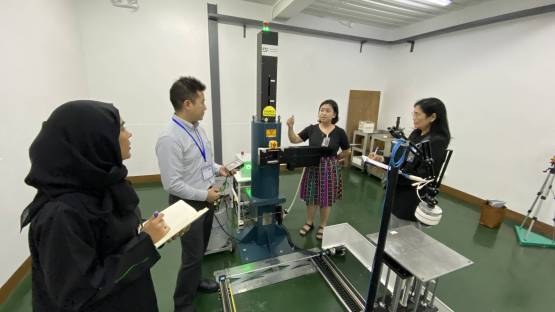Planned improvements to existing regulatory bodies and technical service providers supporting regulatory infrastructure, as well as the establishment of formal certification, recognition and designation of radiation protection officers, were among the key recommendations of a recent Occupational Radiation Protection Appraisal Service (ORPAS) mission to the Philippines.
“These recommendations will result in more effective cooperation and coordination between national authorities and operators of facilities involving ionizing radiation exposure for the enhancement of the country’s occupational radiation protection arrangements,” Said Burcin Okyar, Coordinator of the mission and Radiation Safety Specialist in the IAEA’s Occupational Radiation Protection Unit.
ORPAS missions provide independent reviews of legislation, regulation, and practical implementation of requirements at facilities and technical service providers, regarding occupational radiation protection. They are intended for organizations that utilize radiation in facilities or activities, technical service providers, and regulatory bodies.
In the Philippines, over 22 000 workers are occupationally exposed to radiation. ORPAS Mission experts visited 16 facilities comprised of two national regulatory bodies, namely the Nuclear Regulatory Division of the Philippine Nuclear Research Institute (PNRI) and the Center for Device Regulation, Radiation Health and Research (CDRRHR) of the Food and Drug Administration; four technical service providers; four medical and six industrial facilities that have workers who are occupationally exposed to ionizing radiation, to evaluate the existing occupational radiation protection arrangements.
This mission, which took place from 3 to 11 October 2022 was conducted by an international team of nine reviewers and one observer from nine countries in conjunction with IAEA coordinating staff. The government of the Philippines requested this mission for an independent opinion on the current arrangements for occupational radiation protection in the country, following the country’s adoption of new national regulations within PNRI and CDRRHR more in line with the IAEA’s safety standards. Additionally, the country wanted an overall assessment of gaps and potential improvement areas within the existing regulatory framework.
During this mission, the team concluded that the Philippines had a comprehensive regulatory framework for occupational exposure when compared with requirements of the IAEA’s International Basic Safety Standards found in GSR Part 3 and recommendations provided in General Safety Guide on Occupational Radiation Protection — GSG-7. This comprehensive regulatory framework includes areas such as safety assessment, dose recording, authorization of technical service providers, education and training of qualified experts, and overall optimization of protection and safety related requirements.
“The mission can be assessed as successful with excellent collaboration of Filipino counterparts with ORPAS team members during the mission,” said Aayda Al Shehhi, ORPAS Team Leader from the Federal Authority of Nuclear Regulation of the United Arab Emirates. “The ORPAS Team appreciates the open, cooperative and transparent approaches of all national counterparts who are keen for possible improvements and development of new visions in the field of occupational radiation protection.”
Utilizing a team of highly qualified professionals with different specialties, ORPAS mission experts identified a review strategy for the Philippines by focusing on verifying the implementation of regulatory requirements related to occupational radiation exposure for a variety of different facilities, such as radioactive waste management and irradiation facilities. Depending on the type of radiation found at the work environment, one or both of the country’s regulatory bodies will make regulatory requirements for the facility in question. These regulatory requirements are then assessed in their implementation and in how they compare to the IAEA Safety Standards.
“The country’s commitment to continually improving radiation protection of workers and extending safety culture throughout all layers of organizations involved with radiation protection is an important strength of the country,” said Jizeng Ma, head of the IAEA’s Occupational Radiation Protection Unit.
Kristine Marie Romallosa Dean, Supervising Science Research Specialist at the Philippine Nuclear Research Institute and National Coordinator of the ORPAS mission, said: “The findings, recommendations and suggestions from the ORPAS Misson is invaluable for us. The conduct of the mission allowed active technical discussion among the reviewers and counterparts that it was not only an appraisal but a great learning experience as well. It also opened doors for potential collaborations among the counterparts and experts.”
These planned improvements, followed by an increase in the coordination and communication between the two regulatory bodies to adhere to the existing Memorandum of Agreement signed in 2020 until the establishment of the new independent regulatory body, will further advance the nation’s commitment to occupational radiation protection.
The ORPAS team was made up of reviewers from the United Arab Emirates, Japan, Singapore, Malaysia, Bosnia and Herzegovina, Lithuania, Bangladesh, Türkiye, and observer from Thailand.
Did you know:
Occupational exposure to ionizing radiation can occur in a range of industries, medical institutions, educational and research establishments, and nuclear fuel cycle facilities. Around 24 million workers worldwide are exposed occupationally to ionizing radiation, and of these, about 13 million workers in occupations that involve natural sources of radiation and 10 million in occupations that involve exposure to man-made sources of radiation.
While their exposure is mostly a consequence of the normal operation of the facilities they work in, they may occasionally also be subject to excessive dose as a result of an accident. Appropriate levels of radiation protection of workers are essential for the safe and justified use of radiation, radioactive material and nuclear energy.
The IAEA Safety Standards provide a robust framework of fundamental principles, requirements, and guidance to ensure safety. They reflect an international consensus and serve as a global reference for protecting people and the environment from the harmful effects of ionizing radiation.





